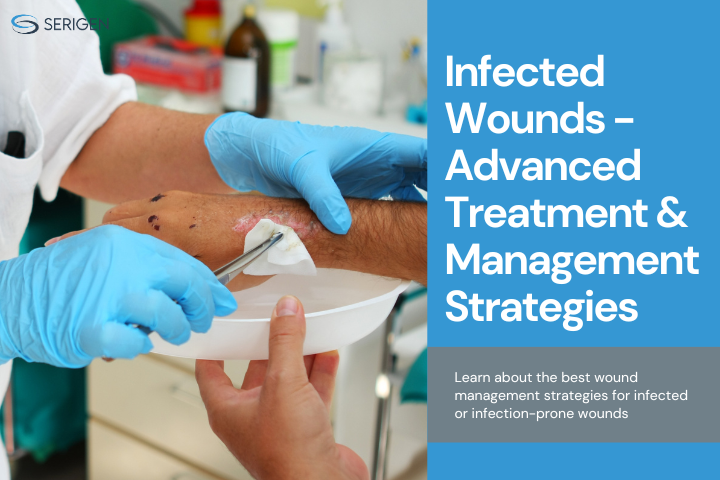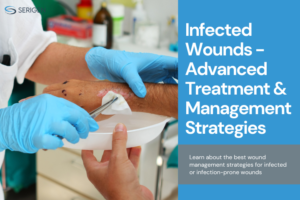Infected Wounds - Advanced Treatment and Management Strategies

Wounds can be surgical (cuts made during an operation), or a consequence of trauma. Traumatic injuries might arise from falls, accidents, bites, or encounters with weapons, presenting as cuts, lacerations, or grazes. When bacteria or other pathogens infiltrate a wound, it can lead to infection. Indicators of wound infection encompass heightened pain, swelling, and redness. Advanced infections could provoke symptoms like nausea, chills, or fever.
Infections represent a significant risk factor for wounds, with even clean surgical wounds showing infection rates of 8% among the general population and 25% among individuals aged 60 and above. This eventually leads to delay in the healing of the wound and hence needs wound care and treatment to reduce the infection at the wound site and even systemic symptoms.
In the following sections we will see why these wound infections are difficult to treat and the advanced treatments that can be used to treat them.
What are infected wounds and why are they trickier to manage than normal wounds?
Untreated infected wounds typically contain multiplying bacteria that may form biofilms, colonies of bacterial cells which are protected by an extracellular slime layer. Within these wounds, both bacteria and inflammatory cells of the patient’s body release enzymes that degrade the skin tissue. The pathogenic bacteria secrete toxins, leading to skin cell death, necrosis, and pus formation. These infections frequently interfere with the natural wound healing process and can escalate into systemic infections with severe symptoms, if untreated. Managing these wounds becomes challenging as biofilm bacteria develop resistance to traditional antibiotics and even to the body’s immune system.
How to treat and control infected wounds?
The treatment plan is determined based on the infection’s stage. Localised infections are managed using wound dressings infused with antimicrobial agents to diminish the infection at the wound location. In situations where the infection advances to a systemic level (i.e. it spreads in the patient’s body), a combination of antimicrobial wound dressings and systemic antibiotics becomes necessary. To evaluate the effectiveness of these treatments, a two-week challenge is undertaken, by reviewing the infection’s progression or reduction. Consequently, the treatment approach can be adjusted as needed. Therefore, selecting the appropriate wound dressing is crucial, considering the severity, location, and nature of the wound infection.
What are the ideal properties of wound dressings for infected wounds?
A dressing has several crucial purposes for any wound:
- Acting as a physical barrier to prevent microbes from entering, colonising, and multiplying within the wound
- Easing pain
- Shielding the wound from further trauma
- Maintaining the wound’s temperature and moisture levels
- Absorbing any exudates and debridement
- Offering psychological comfort
In cases where wounds are infected, the dressing should include an antibacterial agent which helps in reducing the bioburden in the wound. These antibacterial dressings play a significant role in controlling localised infections and are often combined with systemic antibiotic therapy in cases of systemic infections.
An overview of antibacterial agents used in wound dressings
Antibacterial agents with broad spectrum inhibitory activity are integrated into dressings, including Chlorhexidine, Polyhexamethylene biguanide (PHMB), iodine, honey, antimicrobial peptides (AMPs), metal oxide nanoparticles, and naturally derived compounds from plants etc. Notably, silver salts are predominantly used in wound dressings because they release silver ions directly at the wound site upon contact with moisture in the wound. The ions interact with nearby cells and proteins. They exhibit potent antibacterial properties by affecting the crucial bacterial processes such as respiration, nutrition, cell division, and even by destabilising the cell wall that encloses cellular contents. Use of silver limits exposure to antibiotics and reduces the risk of developing antimicrobial resistance.
Why is Seriderm Ag one of the best dressings for infected wounds?
Seriderm-Ag is a cutting-edge wound dressing in modern wound care. The combination of silk and silver harnesses the natural healing properties of silk along with its biocompatibility, and the potent antimicrobial activity of silver. The silk dressing creates a protective yet breathable barrier over the wound, promoting a moist environment conducive to healing while preventing infections. Incorporation of silver enhances its antimicrobial efficacy, effectively combating a wide spectrum of pathogens. This synergistic blend accelerates the wound healing process and also minimises the risk of complications, making it a promising option in advanced wound management.
References

Author Bio –
Swarali Hirlekar is Associate – Regulatory at Serigen Mediproducts. She holds a PhD in Biological sciences from CSIR-National Chemical Laboratory and has 3 years of professional experience in academic research.

Wounds can be surgical (cuts made during an operation), or a consequence of trauma. Traumatic injuries might arise from falls, accidents, bites, or encounters with weapons, presenting as cuts, lacerations, or grazes. When bacteria or other pathogens infiltrate a wound, it can lead to infection. Indicators of wound infection encompass heightened pain, swelling, and redness. Advanced infections could provoke symptoms like nausea, chills, or fever.
Infections represent a significant risk factor for wounds, with even clean surgical wounds showing infection rates of 8% among the general population and 25% among individuals aged 60 and above. This eventually leads to delay in the healing of the wound and hence needs wound care and treatment to reduce the infection at the wound site and even systemic symptoms.
In the following sections we will see why these wound infections are difficult to treat and the advanced treatments that can be used to treat them.
What are infected wounds and why are they trickier to manage than normal wounds?
Untreated infected wounds typically contain multiplying bacteria that may form biofilms, colonies of bacterial cells which are protected by an extracellular slime layer. Within these wounds, both bacteria and inflammatory cells of the patient’s body release enzymes that degrade the skin tissue. The pathogenic bacteria secrete toxins, leading to skin cell death, necrosis, and pus formation. These infections frequently interfere with the natural wound healing process and can escalate into systemic infections with severe symptoms, if untreated. Managing these wounds becomes challenging as biofilm bacteria develop resistance to traditional antibiotics and even to the body’s immune system.
How to treat and control infected wounds?
The treatment plan is determined based on the infection’s stage. Localised infections are managed using wound dressings infused with antimicrobial agents to diminish the infection at the wound location. In situations where the infection advances to a systemic level (i.e. it spreads in the patient’s body), a combination of antimicrobial wound dressings and systemic antibiotics becomes necessary. To evaluate the effectiveness of these treatments, a two-week challenge is undertaken, by reviewing the infection’s progression or reduction. Consequently, the treatment approach can be adjusted as needed. Therefore, selecting the appropriate wound dressing is crucial, considering the severity, location, and nature of the wound infection.
What are the ideal properties of wound dressings for infected wounds?
A dressing has several crucial purposes for any wound:
- Acting as a physical barrier to prevent microbes from entering, colonising, and multiplying within the wound
- Easing pain
- Shielding the wound from further trauma
- Maintaining the wound’s temperature and moisture levels
- Absorbing any exudates and debridement
- Offering psychological comfort
In cases where wounds are infected, the dressing should include an antibacterial agent which helps in reducing the bioburden in the wound. These antibacterial dressings play a significant role in controlling localised infections and are often combined with systemic antibiotic therapy in cases of systemic infections.
An overview of antibacterial agents used in wound dressings
Antibacterial agents with broad spectrum inhibitory activity are integrated into dressings, including Chlorhexidine, Polyhexamethylene biguanide (PHMB), iodine, honey, antimicrobial peptides (AMPs), metal oxide nanoparticles, and naturally derived compounds from plants etc. Notably, silver salts are predominantly used in wound dressings because they release silver ions directly at the wound site upon contact with moisture in the wound. The ions interact with nearby cells and proteins. They exhibit potent antibacterial properties by affecting the crucial bacterial processes such as respiration, nutrition, cell division, and even by destabilising the cell wall that encloses cellular contents. Use of silver limits exposure to antibiotics and reduces the risk of developing antimicrobial resistance.
Why is Seriderm Ag one of the best dressings for infected wounds?
Seriderm-Ag is a cutting-edge wound dressing in modern wound care. The combination of silk and silver harnesses the natural healing properties of silk along with its biocompatibility, and the potent antimicrobial activity of silver. The silk dressing creates a protective yet breathable barrier over the wound, promoting a moist environment conducive to healing while preventing infections. Incorporation of silver enhances its antimicrobial efficacy, effectively combating a wide spectrum of pathogens. This synergistic blend accelerates the wound healing process and also minimises the risk of complications, making it a promising option in advanced wound management.
References

Author Bio –
Swarali Hirlekar is Associate – Regulatory at Serigen Mediproducts. She holds a PhD in Biological sciences from CSIR-National Chemical Laboratory and has 3 years of professional experience in academic research.










